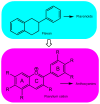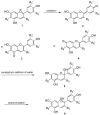Anthocyanin-Rich Purple Plant Foods: Bioavailability, Antioxidant Mechanisms, and Functional Roles in Redox Regulation and Exercise Recovery
- PMID: 40806038
- PMCID: PMC12348956
- DOI: 10.3390/nu17152453
Anthocyanin-Rich Purple Plant Foods: Bioavailability, Antioxidant Mechanisms, and Functional Roles in Redox Regulation and Exercise Recovery
Abstract
Anthocyanin-rich purple fruits and vegetables-such as blackcurrants, blueberries, purple sweet potatoes, and red cabbage-are increasingly recognized for their health-promoting properties. These natural pigments exert antioxidant and anti-inflammatory effects, making them relevant to both chronic disease prevention and exercise recovery. This review critically examines current evidence on the redox-modulating mechanisms of anthocyanins, including their interactions with key signaling pathways such as Nrf2 and NF-κB, and their effects on oxidative stress, mitochondrial function, vascular homeostasis, and post-exercise adaptation. Particular attention is given to their bioavailability and the challenges associated with their chemical stability, metabolism, and food matrix interactions. In light of these factors, dietary strategies and technological innovations to improve anthocyanin absorption are also discussed. The synthesis of preclinical and clinical findings supports the potential of anthocyanin-rich foods as functional components in health optimization, athletic performance, and recovery strategies.
Keywords: bioavailability; dietary polyphenols; exercise recovery; functional foods; oxidative stress; redox homeostasis.
Conflict of interest statement
The authors declare no conflicts of interest.
Figures




Similar articles
-
Prescription of Controlled Substances: Benefits and Risks.2025 Jul 6. In: StatPearls [Internet]. Treasure Island (FL): StatPearls Publishing; 2025 Jan–. 2025 Jul 6. In: StatPearls [Internet]. Treasure Island (FL): StatPearls Publishing; 2025 Jan–. PMID: 30726003 Free Books & Documents.
-
Effectiveness of anthocyanin-containing foods and nutraceuticals in mitigating oxidative stress, inflammation, and cardiovascular health-related biomarkers: a systematic review of animal and human interventions.Food Funct. 2024 Apr 2;15(7):3274-3299. doi: 10.1039/d3fo04579j. Food Funct. 2024. PMID: 38482946
-
Update on the Technological Potential and Biological Properties of Anthocyanins from Grumixama Fruits (Eugenia brasiliensis).Plant Foods Hum Nutr. 2025 Jun 28;80(3):144. doi: 10.1007/s11130-025-01384-x. Plant Foods Hum Nutr. 2025. PMID: 40580218 Review.
-
Anthocyanins From Sweet Potatoes (Ipomoea batatas): Bioavailability, Mechanisms of Action, and Therapeutic Potential in Diabetes and Metabolic Disorders.Food Sci Nutr. 2025 Sep 4;13(9):e70895. doi: 10.1002/fsn3.70895. eCollection 2025 Sep. Food Sci Nutr. 2025. PMID: 40918166 Free PMC article. Review.
-
Polyphenols in Foods and Their Use in the Food Industry: Enhancing the Quality and Nutritional Value of Functional Foods.Int J Mol Sci. 2025 Jun 17;26(12):5803. doi: 10.3390/ijms26125803. Int J Mol Sci. 2025. PMID: 40565272 Free PMC article. Review.
References
-
- Frond A.D., Iuhas C.I., Stirbu I., Leopold L., Socaci S., Andreea S., Ayvaz H., Andreea S., Mihai S., Diaconeasa Z., et al. Phytochemical Characterization of Five Edible Purple-Reddish Vegetables: Anthocyanins, Flavonoids, and Phenolic Acid Derivatives. Molecules. 2019;24:1536. doi: 10.3390/molecules24081536. - DOI - PMC - PubMed
Publication types
MeSH terms
Substances
LinkOut - more resources
Full Text Sources
Medical

